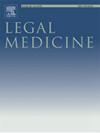Identification of an unidentified corpse with gingival overgrowth: A case report
IF 1.3
4区 医学
Q3 MEDICINE, LEGAL
引用次数: 0
Abstract
Drug-induced gingival overgrowth (DIGO) is a common side effect of drugs, such as phenytoin, cyclosporine, and calcium channel blockers, which mainly affect the connective tissue of the gingiva. In some cases, severe gingival enlargement may obscure tooth crowns, which are easily recognizable by clinical internists and dentists. However, there are few reports on personal identification using DIGO and drug analysis. An unidentified Asian woman with a middle-to old-aged appearance was found dead in a river. DIGO was suspected based on the findings of severe gingival overgrowth and the results from liquid chromatography-tandem mass spectrometry, which detected several prescription drugs including a calcium channel blocker, amlodipine. This information led the police to identify potential candidates in nearby hospitals. Prescription and dental records from the investigation confirmed the identity of the deceased. The discovery of gingival overgrowth is an important indication for suspecting the use of calcium channel blockers, anticonvulsants, or immunosuppressants. This case reminds us that not only knowledge of the tooth findings but also of the gingival pathological findings are important for professionals in forensic fields.
一具牙龈过度生长的不明尸体的鉴定:一例报告
药物性牙龈过度生长(Drug-induced ging龈overgrowth, DIGO)是苯妥英、环孢素、钙通道阻滞剂等药物的常见副作用,主要影响牙龈结缔组织。在某些情况下,严重的牙龈扩大可能会掩盖牙冠,这很容易被临床内科医生和牙医识别。然而,使用DIGO和药物分析进行个人识别的报道很少。一名身份不明的中老年亚洲女性被发现死在河里。根据严重牙龈过度生长的发现和液相色谱-串联质谱分析的结果,怀疑是DIGO,其中检测到几种处方药,包括钙通道阻滞剂氨氯地平。这一信息使警方在附近的医院找到了可能的候选人。调查所得的处方和牙科记录证实了死者的身份。发现牙龈过度生长是怀疑使用钙通道阻滞剂、抗惊厥药或免疫抑制剂的重要指征。这个案例提醒我们,对于法医专业人员来说,不仅要了解牙齿的检查结果,还要了解牙龈的病理检查结果。
本文章由计算机程序翻译,如有差异,请以英文原文为准。
求助全文
约1分钟内获得全文
求助全文
来源期刊

Legal Medicine
Nursing-Issues, Ethics and Legal Aspects
CiteScore
2.80
自引率
6.70%
发文量
119
审稿时长
7.9 weeks
期刊介绍:
Legal Medicine provides an international forum for the publication of original articles, reviews and correspondence on subjects that cover practical and theoretical areas of interest relating to the wide range of legal medicine.
Subjects covered include forensic pathology, toxicology, odontology, anthropology, criminalistics, immunochemistry, hemogenetics and forensic aspects of biological science with emphasis on DNA analysis and molecular biology. Submissions dealing with medicolegal problems such as malpractice, insurance, child abuse or ethics in medical practice are also acceptable.
 求助内容:
求助内容: 应助结果提醒方式:
应助结果提醒方式:


